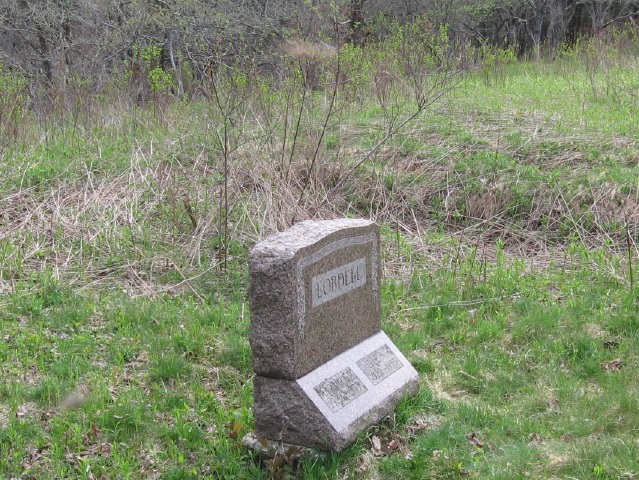Livingston Manor Scout Camps
Beech Mountain Scout Camp - DeBruce
Onteora Scout Camp - Grooville
BEECH MOUNTAIN SCOUT CAMP by Don Gordon <click link> NEW
Beech Mountain Scout Camp Memories
I joined this group a while back, after
I lived in
What kind of interaction if any was there between the village and the camp? Other than traveling through, my only recollections were attending church in LM when my troop spent a weekend at the camp in the fall or spring, and a visit to a local doctor for treatment of an injury one of the summers when I worked on staff. - Jeff
I enjoyed reading your remarks and questions about the
camp and wondered if this is the site you meant:
http://www.billcott
So many things have changed since you were there last, I imagine. I hope
someone can answer your questions, And I wish you much luck in all your
endeavors. Nice to see someone posting. Glad to see someone else appreciates
this informative site about Livingston Manor. May I ask what church you
visited and who was the doctor that assisted you? You didn't mention a
year... so I wondered. Cheers. - Mary Ann
Bill Cotter’s web site about the Onteora Scout Camp is awesome, and I’ve looked through it extensively, but that’s a different camp from the one I attended in 1956-1961. He mentions BMSC on a few pages, even includes a photo of the swimming waterfront, where I worked one of my summers.
“
I could go on, and on, and on – many memories – but I’m at work….
The church? White, probably Methodist or Presbyterian. Really don’t remember it, obviously. The doctor, likewise. I’d guess he had an arrangement with the camp to deal with more serious medical issues than the camp nurse was permitted to handle. He may have been the doctor who administered medical examinations to incoming campers at the beginning of their camp sessions. - Jeff
I was more familiar with the Onteora Scout camp more so than the Beech
Mountain camp. The caretaker and his family lived on the premises at the
Onteora camp and were part of our community. The caretaker's children went
to Livingston Manor Central School and were, and probably still are, friends
to many of us who are part of this site. The Boy Scouts and their leaders
were often in town, picking up supplies of groceries or hardware, especially
during their winter jamborees.
The early history of the development of the Beech Mountain site begins with
the person of Patrick Harvey Flynn. Flynn was an engineer and contractor
from New York City who was responsible for many of the city's infrastructure
projects during the latter half of the nineteenth century, including the
piers of the Williamsburgh Bridge, the trolley system to Coney Island and
Newark's municipal water system. He amassed a large fortune as a result of
these projects, but decided to abandon the rigors of city life to that of
the country, accumulating in the late 1890's over 1,350 acres in the Town of
Rockland at the Hodge Pond area and building an elaborate mansion
over-looking the pond to live the remainder of his life in seclusion.
I know of no photographs that survive showing his Hodge Pond residence but
upon inspection of the property it appears to have been along what was once
the town road that led up from Mongaup to Shin Creek. In the general area
are existing numerous small structures, probably bunk houses used by the
scouts, those that survive are in a general condition of decay. In front,
there are remains of a foundation from what appears to be a large structure,
the foundation segments that survived made of laid-up stone. Entrance steps
to the structure as well as the driveway location can also be noted amongst
the briers and brambles.
The location is on the east side of the pond, at the junction of town road
and the trail that led to the top of Beech Mountain. I can not be positive
that this is the Flynn residence since no photographs have yet to be found.
Since the house burned down in 1926, it would not have been there when the
Boy Scouts purchased the property. Did the scouts have any large structure
in this general area besides those bunk houses? - Fred
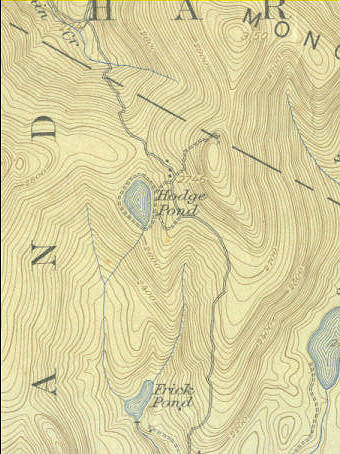 Included is the
Neversink quadrangle of the U.S.G.S. topographical maps showing the Hodge
Pond area. The edition of the map, as well as the survey, has a date of 1910
but was republished in 1936.
Included is the
Neversink quadrangle of the U.S.G.S. topographical maps showing the Hodge
Pond area. The edition of the map, as well as the survey, has a date of 1910
but was republished in 1936.
If the buildings that show along the east side of Hodge Pond were those that
existed in 1910, then they would be part of the P.H. Flynn residence. But if
the 1936 republished edition kept current with structures, then it is
unknown what these buildings were, though it still would be before the era
of the Boy Scouts. - Fred
I sincerely thank you both for the historical information about Beech
Mountain Scout Camp. Fred, it appears from your message you’ve recently been
through part of the former camp. My wife and I covered a lot of the same
territory about two years ago. Between that hike and my experience there as
a scout, I can tell you the following about the area you described:
The area was known (or at least I think of it) as the “family area”. When a
scoutmaster’s family accompanied him to camp with his troop, his family –
wife and young children, generally – would spend most of the day in that
area. I remember families coming to meals in the main dining hall along with
all the campers. My assumption is that the families slept in the small
cabins you described.
You may have noticed that one of the “cabins” was actually a bathroom
facility. I don’t remember details from my recent hike – there may have been
an obvious shower area in it, or one or more toilets or both – but there was
the general impression of a bathroom facility.
Vestiges of a larger building define the location of… a larger building. I’m
not sure how this was used in conjunction with the family nature of the
area, but my guess is that it provided a sort of living room where several
families could gather, wives commiserate, kids play indoors on a rainy day,
stuff like that.
The troop I belonged to (From Cornwall-on-Hudson) used that larger building
once or twice a year for a weekend camping experience, as did many other
Orange and Sullivan County troops on other weekends. It was divided into two
rooms – kitchen and dining area/bunk-room. I’d guess the kitchen was ~10’ x
24’, the other room ~24’ x 48’. There was a big old stove in the kitchen,
don’t recall what fuel it burned, or what other furnishings and equipment
filled the rest of the kitchen. The other room had – a guess – twelve
bunk-beds, one or two dining tables with benches, and a big stone fireplace.
The appearance of the family area –open fields (lawn?), the large fir trees,
the well uphill from the top of the open area – along with its proximity to
the road all suggest this as a likely location for the mansion you
described. Put all that together with the old map that just came in from
Kathy Fries, and I think we can be pretty sure that’s where the mansion was
located.
I have a topographic map at home (lunchtime at work now). From memory I
think it’s from the fifties and shows the main camp buildings that were
south and west of Hodge Pond as well as the buildings you saw, Fred, and the
large building I described above.
There’s more I’d like to add and will do so from home this evening. - Jeff
Back in 1955 or 1956 I located the Flynn mansion, and later confirmed the
location with Fred Owens, who was the Beech Mountain caretaker at that time.
I was the marksmanship counselor, and so I was at the rifle range most of
the day. The troops from the two reform schools were not allowed to take
riflery so I used to have time on my hands when they would have been at the
range, and I used to wander around the general area looking at stuff.
Somebody – Bill Engert, maybe – had talked about the Flynn mansion and I
decided to find it.
To reach it, you start at what you correctly identified as the family area,
and proceed along what, when I was there, was the remains of a dirt road
that ran down to Shin Creek, turning into a real road some distance down the
road, at the house of Irving Berlin, the composer.
The remains of the mansion were, even back in the 1950s, overgrown with tree
growth. My memory is not clear just how far along the road from the family
area the site was, but a quarter of a mile is probably a good guess at this
point. It was definitely before the road starts the downhill to the Irving
Berlin place. The mansion itself was located on the right hand side of the
road if you are walking towards the Shin Creek end of the road. It was maybe
75 feet back from the road. You could see some remains of foundations above
the ground, as well as places where the ground was depressed (the cellar I
would say). I remember finding some white hexagonal tiles like you would see
in a bathroom or kitchen of a fancy house back then. It was a good sized
house, and if my memory is good on it, I would say about 80’ across the
front and about 50’ front to back.
I’m thinking that there was probably a view of something back when the
mansion was built, but the trees were too grown up to see anything even in
the 1950s. - Geoff
The location you describe appears to coincide with one of the buildings
on the map provided by Kathy Flynn earlier today.
Also, looking at the old map, and imagining a vista void of trees, the house
would have overlooked Hodge Pond.
Big house. Amazing to be way out in the woods like that.
Do you by any chance remember Waterfront Director Chet Blomquist? I think he
started in the mid fifties, ran the waterfront for fifteen years or so. I
camped and worked on staff at Beech Mountain 1956-1961, including one summer
on the waterfront. I talked with Chet late in 2005 or early 2006. - Jeff
Thanks for the information concerning Hodge Pond. Apparently the
foundation that I described would probably be the structure that existed in
the family area, as described by Jeff. Unless this building was built on the
same foundation, the foundation I described would not have been P.H. Flynn's
residence.
It seems like deja-vu all over again for I believe that Geoff and I had this
discussion on this site a number of years ago, for I remember looking for
the remains that he described. I believe I remember seeing this location,
and noticing the disturbance in the landscape that a structure would create
but couldn't help but wonder why a residence, especially one of the supposed
grandeur of Flynn's domicile, would be located there. It was far enough away
from, and with the local topography not within the view of the pond. It also
did not appear to be near enough to the road drop-off heading to the Shin
Creek valley for any view of the valley, trees not withstanding. I surmised
the first location that I described, but it was only a quess, for the fact
there was a spring there, no doubt being developed by the scouts, but
possibly used before by Flynn. I failed to find any springs at the site
further down the road. I will try to revisit this site again before being
covered in snow. - Fred
I looked at the map after I wrote my post, and I think you are absolutely
right. Thinking back further, I think that there were a couple of
depressions near the big building with the fireplace – on the side toward
the road running down to the lake – that could have been former buildings of
that estate. They were in tall grass, so they were not obvious, but I think
they were there.
Yup I do remember Chet Blomquist. I had not thought of him in years, decades
maybe, but I do remember him now that you mention his name. I think 1956 was
my last year on the staff (I started out on the staff as the 12 year old
bugler in 1953 because they were desperate for a bugler, and after I had
been on the staff they couldn’t really make me be a camper again, so I got
mostly make-work jobs for the next three years).
I get the impression from the earlier posts that Beech Mountain is no longer
an active scout camp. Any idea when they stopped using it, and why, and who
owns it now? It was really a pretty spectacular place. - Geoff
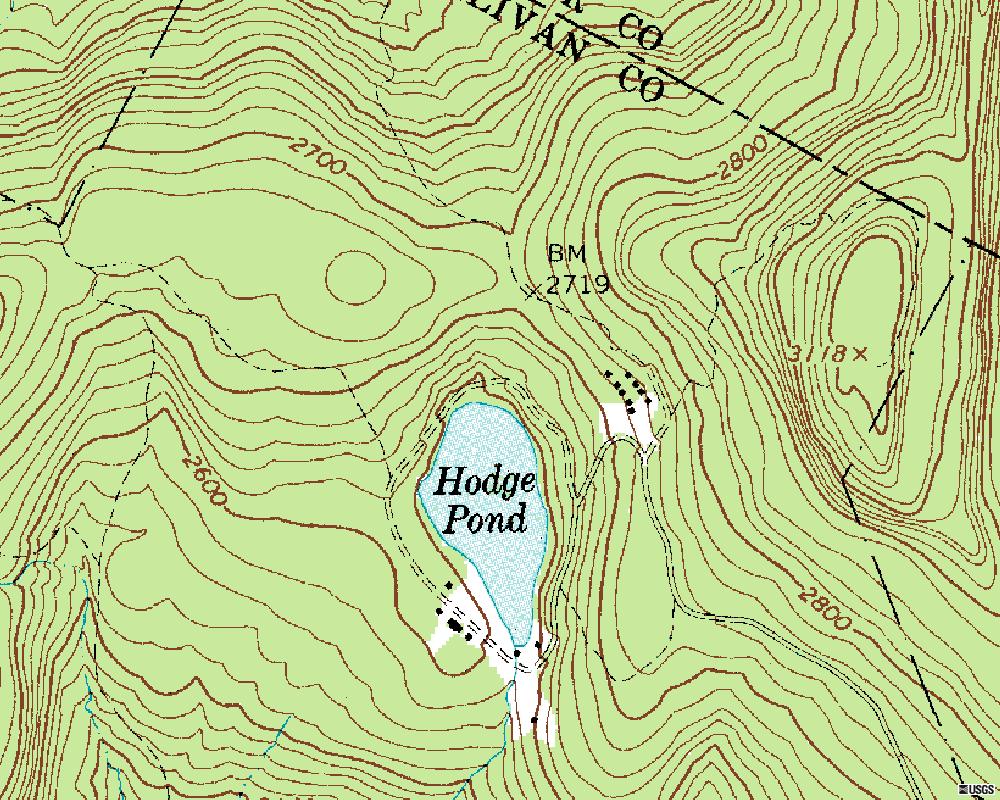
Turns out the map I had at home was printed in 1944 and based on aerial
photography done in 1942 – part copy attached. It shows one building that
seems to coincide with the Flynn mansion.
The mental map image of multiple scout camp buildings south and west of
Hodge Pond apparently came from an online map you can see at http://terraserver.microsoft.com/image.aspx?T=2&S=11&Z=18&X=1309&Y=11618&W=3&qs=%7cDebruce%7cny
This map is referred to as a topographic map made in 1981. All the main
camping area buildings are shown, and two rows of buildings in the family
area. It’s not clear whether the large family area building is one of the
nine that are shown, but I think it might be the southernmost of the group.
Fred, if you get up that way again, it might be interesting to note how many
small cabin remains are still visible. I’d be interested in your thoughts on
whether the large building is shown on the 1981 map.
If you look at the web site I listed above, you’ll see a tab for “Aerial
Photo” of the same area, dated May 1997. The main camp area buildings are
definitely gone, and I wasn’t able to discern any buildings in the family
area. The small cabins have to be there, of course, because their remains
still exist, but they’re not visible in the photo.
The scout camp has essentially ceased to exist, apparently some time between
1981 and 1997. I drove there – or tried to – some time in the nineties, and
got as far as the ranger’s cabin. It was obvious there was no longer a camp
farther up the road, because the road was all grown up with grass and weeds.
As I sat there contemplating this unexpected sight, a woman came over from a
clothes line beside the cabin and asked if she could help me.
According to her, the camp property had been sold to a hunting club, and had
not been a camp for years.
More recently, I’ve learned, it was bought by a conservation organization
that allows a certain amount of hiking activity on the land, camping “with
permission”. There’s a parking area just south of the ranger’s cabin, a
trailhead map, and other information which I have at home, if you’re
interested.
I have lived north of Albany, NY since 1970 and it’s not convenient for me
to get back to that area, much as I would like to, and roam around some
more. The exceptions have been the drive in the nineties and the hike a
couple years ago.
Walking around there, if you knew where to look, there were many, many signs
of the land’s former use. You can get some idea from the aerial photo
described above. The roads are all still there, the clearings, the small
cabins.
In the summer, my troop usually used the campsite above the office and
trading post building, and I found the path up that steep hill,
discontinuous stone steps still in place. It was all very familiar, even
though I hadn’t even thought about it for nearly fifty years.
I found a concrete slab in the ground on the shore of the pond – you may
remember the tower on the waterfront, and the “buddy board” at its base. The
slab was under the buddy board. - Jeff
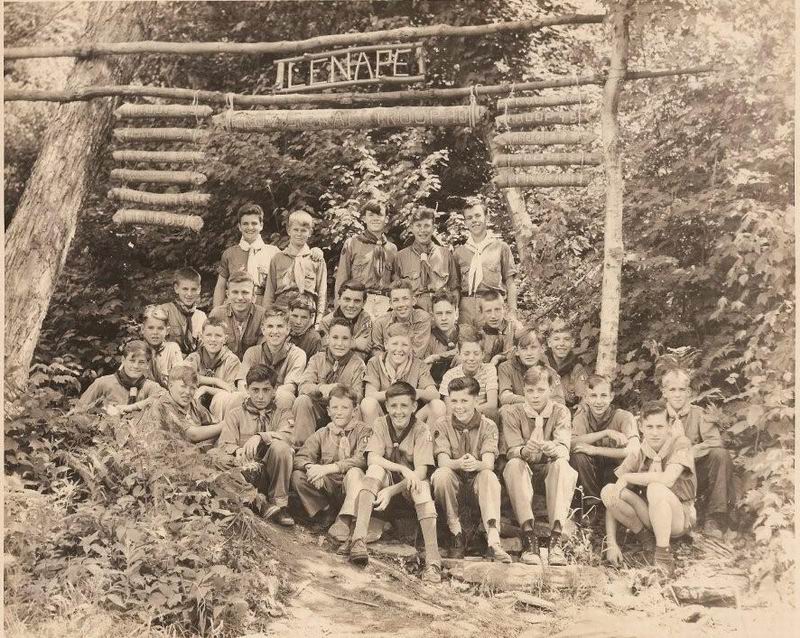
First summer of Lenape camp site at Beech Mt. Scout Camp. Best recollection
circa 1948. in 49 we spent one week prior to the Philmont trip to get to
know each other.. - Gregory De Blase
Third row up, starting second person (l/r) Jack Sherwood, Charles Dutcher,
me, Burr Hartig.
I wonder what happened to the Boy Scouts in the area. It must have gone
out of style or something – although I guess “progress” could have done it
in also, as they would probably nowdays have to have flush toilets, and all
kinds of other modern conveniences to be considered a safe place. It seems
to me that we had a pretty good deal. It was really a huge tract of pretty
wild country we had, and I could compare it with Ten Mile River, which was
really a lot like an RV park as I remember it.
I’m trying to remember the names of the various camping areas at Beech
Mountain. There was Lenape and (I think) Iroquois on the hill above the
parade grounds. South of the admin building and parade grounds was the staff
area (there is a building shown there on the topo map you linked – aside
from being a place where the Order of the Arrow stuff was kept, I never
understood why they even had that building.) Then there was Towanda
campsite, pretty much opposite the Nature Lodge. Then the Mess Hall facing
the waterfront, and the Health Lodge, and the shower building. Then there
was Shawnee campsite, and then Sioux (or was there one in between them?) and
then there was Blackfoot out in the woods at the end. Someplace on the lake
there was the ampitheater, and I realized I could get a really good echo off
the mountain if I played taps from there. Brings back a lot of
memories…. - Geoff
I don’t think scouting has gone out of style, just has a lot of
competition. My son played youth hockey all winter long from age ~6 until he
finished high school. Practice 2x/week, games Saturday and/or Sunday almost
every weekend from October to April or May. His daughters swim, play soccer,
basketball, I’m not sure what all.
There’s a very active troop in my area; if you Google “Beech Mountain”, one
of the hits is a diary of a troop in or near Newburgh I think that’s been
active over fifty years. They’re out there, but I think a smaller percentage
of the population. And as you say,” camping” has changed a lot in fifty
years.
Beech Mountain was quite a place and I don’t know what happened to it, but
it probably was somehow related to money – have to pay the staff more, raise
the fee for campers, fewer campers, etc.
I think you hit the campsites right on the money, even to your uncertainty
about a site between Shawnee and Sioux. I can’t remember if there was
another one either. Our troop stayed in Lenape except 1956 when our
scoutmaster couldn’t go and we stayed in Blackfoot with a “provisional
scoutmaster”. Heh. You remember Don Gordon? - Jeff
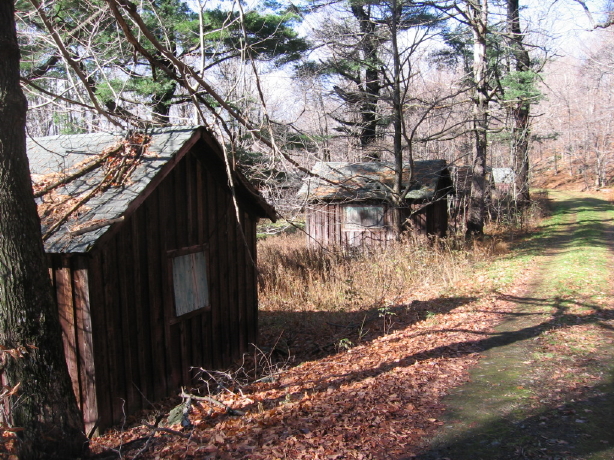
The remaining small cabins behind the location of the family building along
the old Beech Mountain Road. There are nine that are still standing - Fred
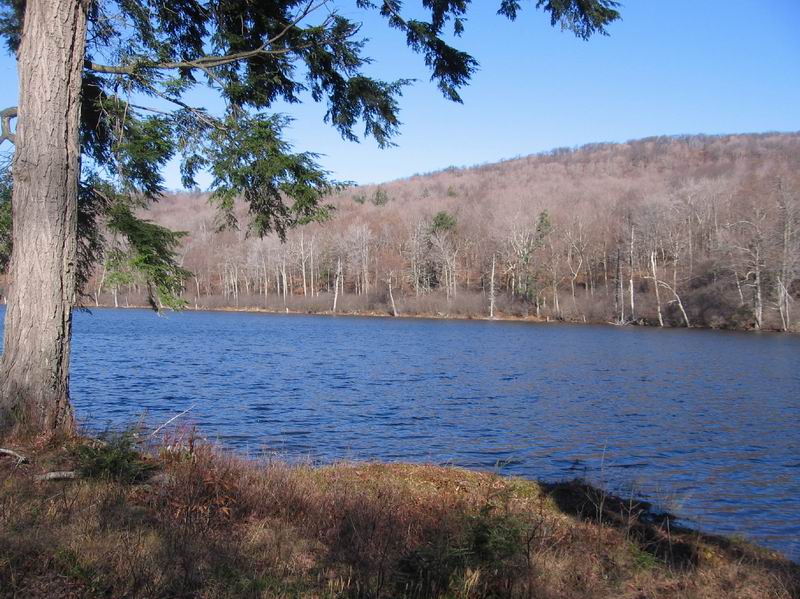
Visited Hodge Pond and area this afternoon. Found little in the way of the P.H. Flynn residence's location. The photograph shows Hodge Pond from the western shore, looking back towards Beech Mountain. The Scout's family area, along with the old Beech Mountain Road, would be midway up the hill, the location is noted by a couple of large spruce trees. - Fred
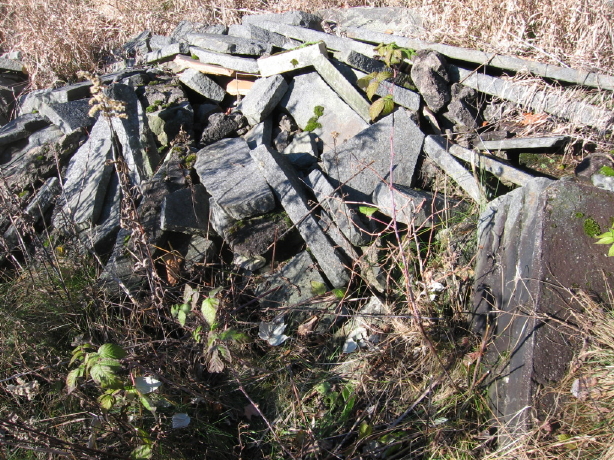
Remains of a building in the location where the family building stood. Debris consists of blue stone, chimney tiles, fire bricks and pieces of concrete and seems to be located along the back side, towards the cabins, of an old foundation. There is a laid stone column, which appears on the right of the picture, which may have either been part of a porch entrance, or stonework along the driveway. The rest of the debris may be the remains of a chimney and most likely the family building. - Fred
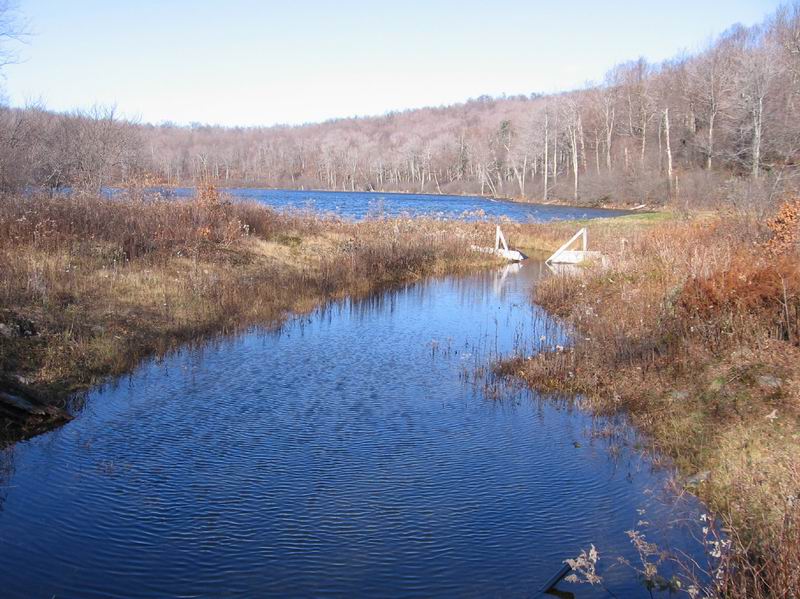
Outlet of Hodge Pond - Fred
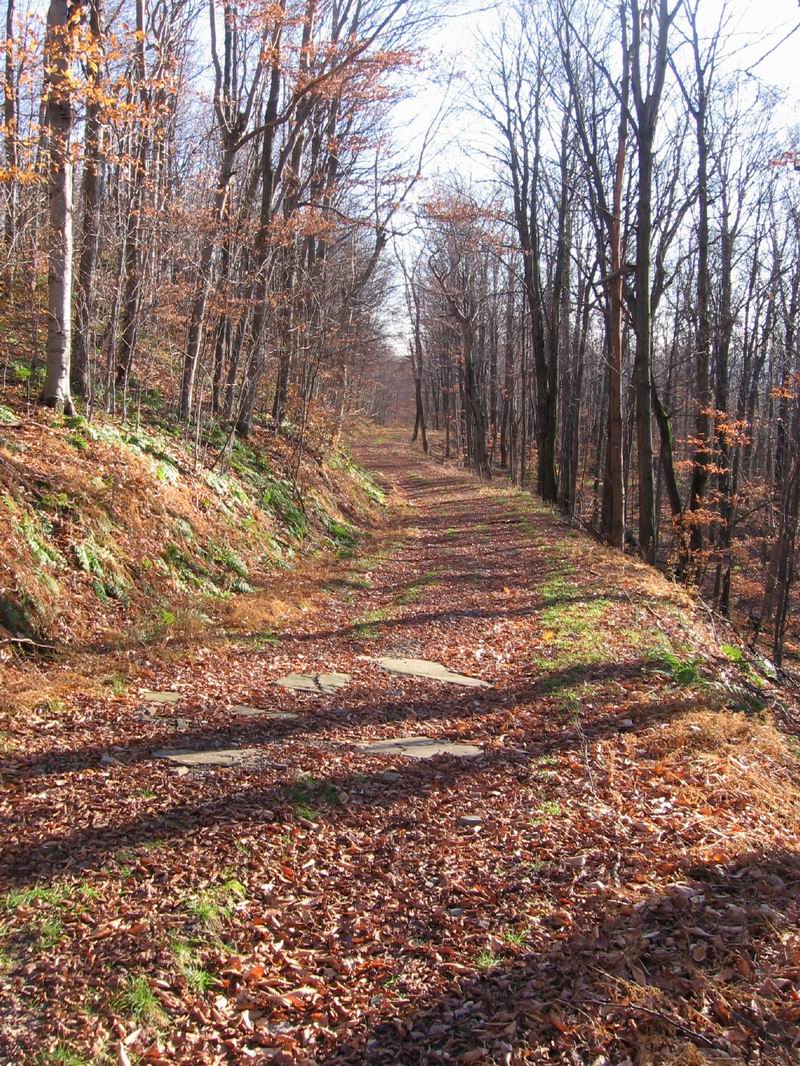
Beach Mountain Road, the abandoned Town of Rockland road that traveled past P.H. Flynn's, later the Beach Mountain Boy Scout Camp. The road left the Mongaup Pond Road, over the divide, to the Shin Creek Road. - Fred
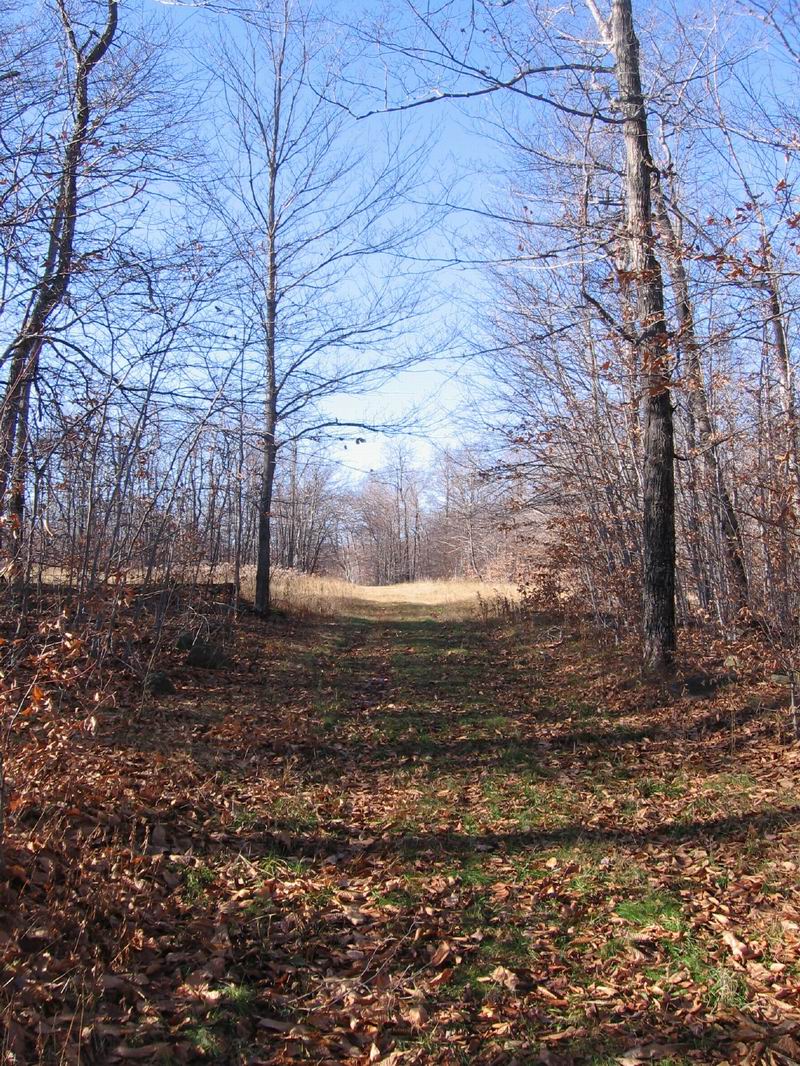
Trail leading to camping area on the west side of Hodge Pond. - Fred
The Hodge Pond - Frick Pond area is now owned by the State of New York
and is open to all. Hiking trails have been developed along some of the old
log roads leading to both ponds, with a designated snow-mobile trail running
through its heart of the property leading from the Mongaup Pond area. The
main trail to Hodge Pond is actually the old Beech Mountain town road,
though it skirts around the residence above the trailhead parking lot, home
of one of the local forest rangers, for a couple of hundred yards before
rejoining the old road. Hodge Pond proper is actually owned, or at least
they have the deed rights, by a conservancy group, consisting of over 250
acres. This includes the pond and Beech Mountain itself, where a ski lodge
has been erected on top and numerous cross-country ski trails maintained.
The view from this lodge is one of the best in the Catskill's, looking
towards the southern peaks of the Catskills, though it is man-made which, by
my viewpoint, takes some of the natural beauty away from its grandeur. The
public is allowed over this property though there are restrictions on
camping and fishing at the lake.
The scouts probably abandoned the property during the early eighty's after
it was logged off (others may be more certain of that date), when developers
bought the property and applied for a subdivision with the town. Part of
their petition required the town to abandoned the road, which they did in
1987. The property was then sold to the state, except for the Hodge Pond
area. Though some members of the Town Board felt, at the time, that they
were double-crossed by this action, it is simply nice to have such an
wilderness area, basking in history from lumberjacks to scouts that is
slowly becoming forgotten by most of us, preserved for all of us to
appreciate. - Fred
Patric H. Flynn was not the type of fellow who would wait for things to
happen; he would make them happen. When the Civil War erupted, a small
matter of being too young to enlist did not deter Flynn from joining, though
he was at most 13 years of age. The "Hero of 1865",as inscribed on his
grave-stone, became part of Grant's army that dislodged the rebels from
their Petersburgh trenches to their final surrender at Appomattox Court
House.
Returning to Brooklyn, he joined in the building of New York City and its
infrastructure, creating a massive personal fortune. From real estate to
trolleys, he linked the two, joining one rail system after another, linking
Long Island with Manhattan, enhancing both his city real estate and his
wealth. It was a power game that he excelled in, playing developer against
developer and politician against politician, dividing those who knew him
into loyal friends or bitter enemies. By 1898, as legal problems began to
sink into his fortune, Flynn desired to escape the city, purchasing the
wilderness area that surrounded DeBruce. No small land deals for our man
Flynn, this estate would eventually encompass over 1700 acres, including two
ponds and the surrounding mountains that overlooks them. To help protect his
wealth, the property was not deeded in his name, but into that of his niece,
Helena Meht, who, with Flynn, retreated to their remote estate. - Fred
"Contractors came from New York Tuesday to erect a house at Hodge Pond, near DeBruce. Mr. Flynn has purchased 2,000 acres of land which will be graded and will contain a park and fish pond. No expense will be spared to make it one of the most desirable of country residences." - July 10, 1898 - Walton Daily Reporter
The story that circulated at Beech Mountain was that most of the work on the place was done by NYC employees on the public payroll. Anyone ever hear that? - Geoff
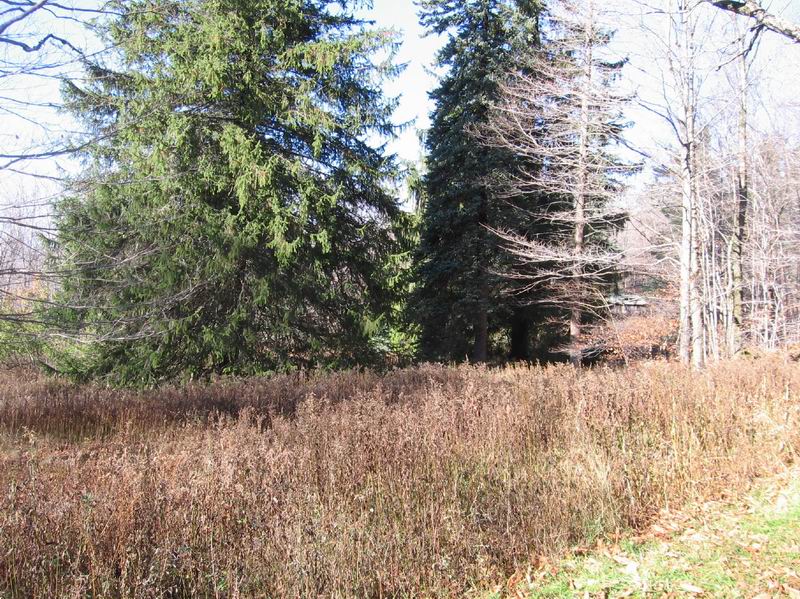
The foundation for the "family house" was located behind the spruce trees. I believe that this is also the general area of the original Flynn mansion, which burned to the ground in 1926. The small cabins can be seen in the background. - Fred
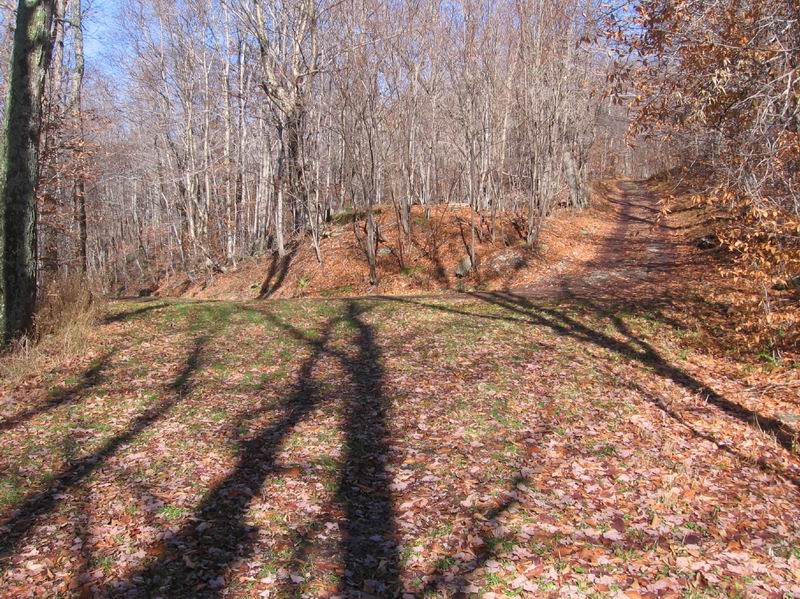
Juncture along the old Beech Mountain town road with the scout's family area to the left of the junction. The trail leading up the hill to the right climbs to the top of Beech Mountain, now to the recently erected ski lodge. The main trail begins its descent toward Shin Creek Road. Foundation remains of the old spring house can be seen at this intersection. - Fred
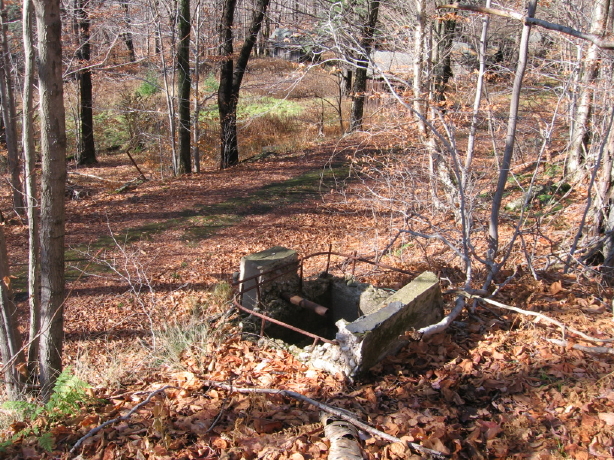
Remains of spring-holding reservoir, along the old town road at Flynn's residence. The small cabins can be seen in the background. - Fred
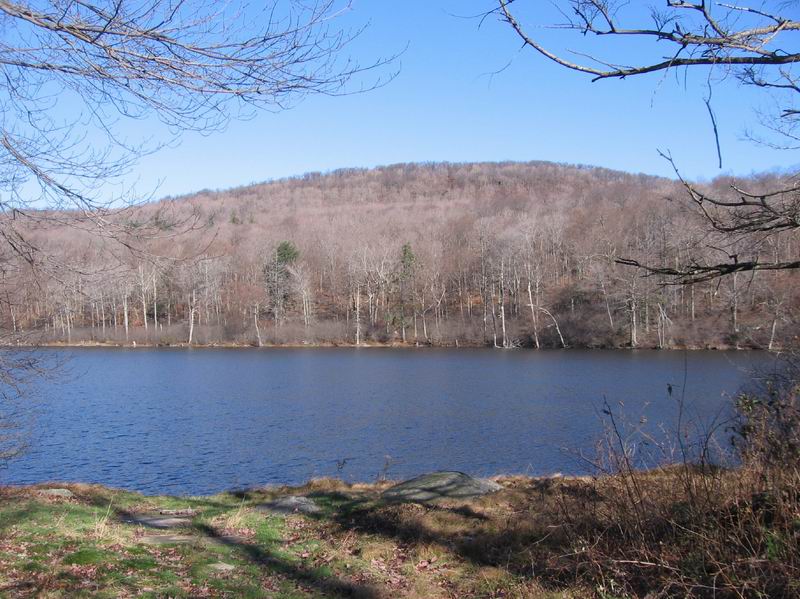
Hodge Pond from the dock area, looking towards Beech Mountain. Beech Mountain, although it is an un-named peak on the topographical map and is considered to be a spur of the neighboring Mongaup Mountain, is actually the highest point in Sullivan County, which was once considered to be Denman Mountain, outside of Grahamsville. - Fred
P.H. Flynn's reclusive DeBruce mansion also did not
shield him from the various legal actions against him. His problems were
mainly self-inflicted, the result of bad decision making or just plain bad
luck.
The Nassau Electric Railroad Company, of which he was president, expanded
during the 1890's with the help of the Brooklyn Aldermen, who favored Flynn,
and his political connections, when giving out the franchises for the
proposed trolley routes. Though Flynn had friends in high places, even in
the Brooklyn judicial system who conveniently would "lose" records, his
railroad was considered a "paper railroad", and in the end could not hold
off the competitors through legal challenges.
Flynn's syndicate bid on the construction of the New York tower of the
Williamsburg Bridge, and though the bridge commissioners thought Flynn was
not up for the job, he foolishly proposed to bond his part of the project
three times more than what was proposed on the contract. The commissioners
accepted Flynn's bid. Problems arose, delaying the finishing of the tower,
which naturally delayed other aspects of the bridge's construction, adding
to Flynn's legal woes.
In the early 1890's Flynn's syndicate joined Henry Beldon of Jersey City and
secured the contract to provide that city with municipal water.
Unfortunately, Beldon soon suffered health problems and became
incapacitated, allowing his brother to alter his will, setting off a legal
battle with the rest of the family that held up the water project for years.
When finally begun, residents along the proposed rivers proposed to be
dammed, claimed riparian rights of water use against Flynn's taking of the
water, delaying the project and a new set of legal problems for Flynn.
Court decisions were mainly not in his favor, and creditors were knocking on
his door. Flynn declared bankruptcy in 1906. - Fred
The trail to Patrick H. Flynn's secluded DeBruce estate
became well-traveled by his creditors, with judgment after judgment going
against Flynn and his syndicate, wiping out his fortune. He had two true
friends left, one being John Baldwin, proprietor of the Manor House in
Livingston Manor. Flynn often stayed at the hotel, especially when he
traveled in winter. On one winter return to the Manor from his downstate
legal problems, Baldwin's hotel cutter and team took Flynn up the DeBruce
road toward his Hodge Pond home. At DeBruce, the snow was so drifted that
the team could not get through. Instead of turning back with the hotel's
sleigh, Flynn continued on, trekking over waist deep snow the last few miles
to his lonely destination.
Harry Hanbury, indebted to Flynn for his political connections and his own
financial success on the docks of Brooklyn, remained true to the end. To
help mask his remaining fortune, which by now was sifting away to his
creditors, Flynn and his niece, Helena Meht, used Hanbury to shield what
remained. When the courts got wind of this, Hanbury was called to testify
against his friend over the transactions made, which he refused to do,
claiming it was a private matter with no connection to the claims against
Flynn. Hanbury was imprisoned for this refusal to answer the court's
questions, the time served until bail was met by some unknown party. - Fred
12-28-2007 - Norman Buck sent me an e-mail with the new(??) L.M. web
site. very nicely done. was particular interested in the Beech Mt. story. I
was very fortunate to have gone there 6 years (45-50). The 50's onward i
have little recollection of, since that is when i entered the Navy and
afterwards relocated to Long Island.
As you remember. my parents owned the Arlington Hotel and L.M. was a very
busy town during the summer months after the war. Most of the resort hotels
were filled to capacity. And to keep me out of their hair i, was sent off to
Beech Mt. for the full summer. our rooms were filled most weekend with over
flow. Too, since most of the hotels were Kosher, the Arlington was one of
the few places the Kosher cliental, without traveling to Liberty, that one
could sit down and have a plate of Chinese roast pork or shell fish.. So off
to camp i went for the summer - (It was only $8.00 dollars a week in 1945)
along with Jack Sherwood, Burr Hartig, and one year Harold Dutcher's boy and
George Van Steenberg. The point i am getting at is the references to some of
the building shown on the topographical maps may have some errors.
Reference to the large structure west of the Hodge Pond (HP) as remains of
Flynn's house was in reality the large new mess hall, built in the fifties
or sixties. The smaller structures just east of the Pond and near the creek
draining HP that fed Frick Pond (FP) was the old mess hall and the trading
post/commissary. Just across the creek was the new nature lodge, built 47 or
48.. continuing on the road on the left were the campsites, with only
platforms for tents. the first one being Towanda, back of which were the
showers. Then came four or five more sites, the last one named Apache. Some
of the sites were for those units that sent a large portion of their troop
for two weeks. one troop i can remember, came from Tuxedo. The larger site
were for boys from mixed troops of Orange and Sullivan County Council, as it
was known then before becoming the consolidated Council, running from
Delaware county to the Hudson river (not sure of other counties ) The Lenape
site mentioned was constructed in 47or 48.. I am mailing you a picture of
the scouts and councilors staying there that first year..
On the other side of the pond road from the camp sites was the camping and
pioneering areas. Then, about half way down the path leading to the Pond was
the leanto for the waterfront crew.. Up through 1950 there were no cabins or
family camping as shown in your pictures or referred to in the comments. At
the far end of the Pond was where the Saturday night campfire was held. with
the camp chief standing in his canoe ,gliding across the water, torch to
light the fire, held high.
Do any of you first year scouts remember on the road side of the pond
sitting on the hill side during the weekly "Snipe Hunt"just after dusk. In
the six years i was at camp i never knew of any scout, with burlap bag in
hand, landing a snipe
The final part of the Beech Mt at the top of the hill was the health lodge,
making a sharp left down the hill the road ended at the parade ground and
the (in the 40's) mess hall was a building. Comments about foundations,
stone slabs may be correct, for the path pass the by the health lodge was
the beginning of a trail that lead to the plane crash site and also to
Flynn's Point, from which you could look some 20 miles or so to Shandlee,on
the other side of L.M. the other side of the point you could look out at all
of the highest spots in the Catskill, i.e.; Slide, Balsam, Double Roundtop,
to name a few.
I am sending a copy of this note to Jack for him to correct, delete, add to
what i have tried to remember. He also has knowledge of ownership and
through whose hand it property pass, which my memory serves correctly came
after the those mention on the web site..
In closing, it matters little if i have made mistakes in my remembering, but
one thing I have not forgotten is, what a wonderful time it was for young
boys who were lucky enough to have been there.
There are memories that will never be forgotten.. Carl Meltzer, who took 20
to 30 boys on their annul trip to Philmont, NM, Carl was the most inspiring
man i knew, for young boys to learn what the concept of Boy Scouting was all
about. Some being -- Confidence in one's self, understanding the meaning of
charity, giving to others the way others had given to you, to try to fulfill
the 12 scout laws at "all times", and the love of God and Country.
An event happened a few years after in the fifties. It was at the National
Jamboree held on the, then, Irvine Ranch which also gone now,"where the wild
goose went".
I was there with the Navy to sent up a radio for the ground crew to
communicate with the Navy's flying "Blue Angles". Since I had attended the
1950 Nat. Jamboree at Valley Forge I ask the Officer in charge after getting
all set up, if I could have some time off to walk around. The ground was
slopping grassing fields.. Up one of the hills, about 400/ 500 yards away
came the tall, lopping young man from Goshen, NY, who recognized me way off,
and with his deep voice gave out loud yell "HEY MEATBALL"
What a wonderful treasure it is to be stuck with a nick name. Not sure of
the number, but i would guess over a thousand scouts, I made contact with
during those 6 years, remembered me long after our Boy Scouting days faded
in to the past, because of that handle.. People, I am sad to say I have
forgotten.
Again Jack is much better at this than I am. A few, thoughts, still remain.
The Order of the Arrow had a W W W acronym for a pass word. Well there was
little fellow (little i say because like my Father was only 5' 6" and he was
smaller than I)... He was given a handle of WWW standing for Wee Willy
Wilkins. Then on the Philmont trip in 49 there was an assistant leader,
forgot his name, if I ever did know it, but i can tell you the color of his,
hair, eyes and facial features. I remember him as Sash-in-door. He was from
Dubuque, Iowa when it was known as the Sash and Door manufacturing capital
in USA. Long before "made in China" became the vogue...
It is nice to have some of the newer, younger, campers from the fifty's on,
but it also would be nice if some campers of the 40's would ring in --
before they like the "Greatest Generation" drop off..
feel free to use any, all or none of this, as you see fit, but don't forget
to get Jack's input.
regards - Gregory DeBlase
The money was gone. All of the wealth Patrick H. Flynn accumulated was
either spent to defend his wealth or else turned over by the courts to his
creditors. that was left was his handsome home and the Hodge Pond estate,
the property which was deeded in his niece's name. Still, this did not deter
his creditors. In 1917, they succeeded in getting a favorable decision from
the Brooklyn courts that stipulated that the DeBruce property, valued well
over $150,000, could indeed be used for payment of judgments against Flynn.
Flynn was on the verge of losing it all, until his last, and possibly now
his only friend, Harry Hanbury, intervened in the proceedings and purchased
the Flynn estate in 1921, satisfying the claims of the creditors, allowing
Flynn and his niece to remain at his secluded home.
The now aged Fynn, whose personal wealth at one time was considered to be in
the millions of dollars, was now living off of his only source of income,
the fifty dollar Civil War veteran's pension and the promises within a box
filled with worthless I.O.U.s by past associates. His lavish home
furnishings were gone. The large mansion, already in disrepair from years of
neglect, further deteriorated, as did his health. He retreated further into
seclusion. Rarely, if at all, did he leave his estate, cutting off all ties
to the outside world, relying on his DeBruce neighbor, Clarence Polhamus, to
bring the necessary supplies for him and his niece up the Flynn trail. -
Fred
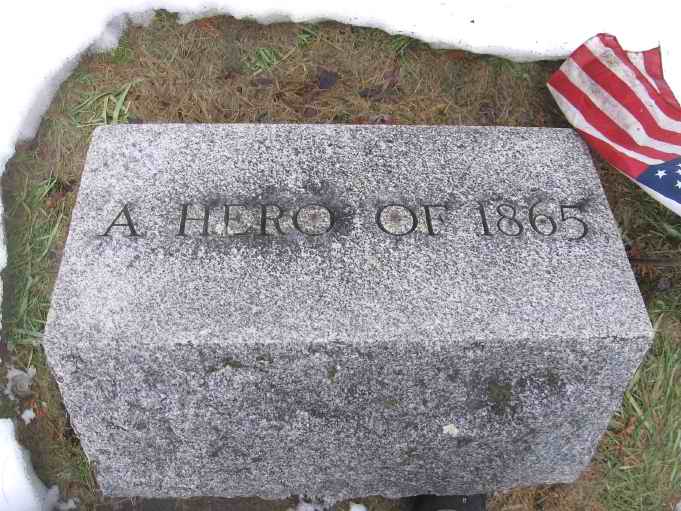
Headstone of Patrick H. Flynn at the Orchard
Street Cemetery
Spring was late in coming to Sullivan County in the year of 1926. The
month of April was so cold that ice was still lodged within the rivers for
the beginning of the year's fishing season. Throughout the month, area
farmers were unable to work over many of their fields due to the remaining
patches of snow. For the month of May, temperatures increased grudgingly as
the month proved to be the coldest in recent memory. And then the rain
stopped. With little rainfall throughout the last half of April and May and
as the snowpack melted, fear of forest fires grew. Forest fires started that
spring at the southern end of the county, with blazes raging around
Bloomingburg, Otisville, Port Jervis, Barryville, Black Lake and Lake
Huntington, keeping the observers positioned on the Conservation Department
fire towers ever so vigilant.
The old Balsam Lake Club firepower overlooked the upper Beaverkill valley
and beyond to the Delaware River highlands as it sat atop Balsam Lake
Mountain, one of the highest peaks in the southern Catskills. On the morning
of May 14th, as the fire tower observer scanned the vista before him, a
cloud of black smoke arose from behind the near ridge to the south, the
ridge that divides the Willowemoc and Beaverkill watersheds. Knowing the
landscape before him as he would the back of his hand, he immediately knew
the general location; above DeBruce, perhaps one of the Mongaup lumber
camps.
With the spring's persistent cold weather, Helena Meht kept the Flynn
residence warm by keeping the fires going in the furnace. Going about her
duties in caring for the frail and invalid Mr. Flynn, she heard the
explosion upstairs. Upon investigation, she came upon a wall of smoke and
searing heat as the upper story room in which the chimney passed through was
ablaze, driving her back down to the first floor. There was no time for her
to attempt to extinguish the blaze, but only to find her aged uncle through
the smoky haze and vacate the building as soon as possible. It was no easy
task, but she succeeded, both of them leaving the premises just as the whole
structure erupted in flames. They could only watch as the once-glorious
Flynn mansion disintegrated into pile of embers.
When the Livingston Manor firemen arrived, the main building was already
down, but because of the dry conditions, the lawn and neighboring woods were
set ablaze, threatening the nearby cottages and barn. With great effort, the
blaze was subdued by the firemen and the remaining buildings were saved. As
for Patrick Flynn, he too was saved from the blaze, though barely. With the
destruction of his handsome home and his prized furnishings, the fire
finally took what his creditors could not; his will to live on. - Fred
Patrick H. Flynn was a quiet, unassuming man, who rose from poverty to
prominence due to his unlimited energy, unfailing memory and devoted
loyalty. Though uneducated, his early years were spent working on the docks
of Brooklyn by day and attending school at night, realizing that he needed
to hustle and scheme if he was to succeed. By dealing in real estate, Flynn
made his wealth; the accumulation of street railroads brought him political
power; construction contracts brought him powerful enemies, and the
beginning of his downfall; the DeBruce mansion gave him seclusion and the
unsuccessful escape from the world he helped create. After the was
increasingly deteriorating, made plans for one more scheme; the planning of
his funeral.
At first it was thought that Flynn could remain at Hodge Pond, staying with
Helena at the smaller cabin that was saved from the flames, but his health
demanded access to better care than the primitive cabin provided so the
couple moved to Clarence Polhemus's residence outside of DeBruce. Here,
Flynn began working on building his coffin, a simple pine box made from the
pine lumber from his estate. The headstone was ordered, a block of pink
granite, with humble and simple words inscribed on the smooth face, denoting
his pride as well as his modesty in only a few short words. Flynn was now
ready.
Flynn died a month after the fire, on the morning of June 15th, 1926. His
funeral, as was his desire, was attended by only three individuals; Judge
William McGrath of the Manor, who helped oversee his final legal affairs,
John Baldwin, in whose Livingston Manor hotel Flynn often stayed, and Harry
Hanbury, his only loyal friend from his Brooklyn past. The headstone placed
upon the grave gives no indication of the individual buried underneath; no
name being inscribed on its finished surface. Only the reference to an
episode in his life, recalling his youthful days marching with General
Grant's Union Army; "A Hero of 1865". - Fred
The Flynn estate at Hodge Pond, without the elaborate mansion that had
burned to the ground, now only consisted of the smaller cabin and barn,
which now was used by Harry Hanbury as a hunting lodge. A portion of the
Flynn tract included the old Burton place, situated along the outlet of
Hodge Pond. Benjamin Frick, another New York capitalist, purchased the farm
in 1900, built a handsome residence, though on a smaller scale than Flynn's,
and where the small stream passed over the remains of old beaver ponds,
erected a dam across the stream to create a trout pond. He never realized
his final vision of the place for Frick passed away within a year, his name
still survives on the remains of his pond.
At the time of Patrick Flynn's death, the upland forests surrounding
DeBruce, were now being harvested by lumber companies, large business
concerns from Pennsylvania. Large lumber camps sprung up on either side of
the Flynn tract, where the lumberjacks both worked and lived. The largest of
these camps was the Reese-Sherriff camp on Orchard Lake, cutting timber off
of the old Hammond and Prindle tracts.
Hanbury, immediately after Flynn's death, went into contract with Ernest
Archer, of Titusville, Pennsylvania, selling off the timber rights of the
property, except for the area around Hodge Pond and the original location of
the Flynn buildings. The Archer lumber camp was created on the Frick
residence, and populated with woodchoppers and sawyers brought from
Pennsylvania, with smaller camps located wherever the portable mills were
located.
Hanbury, ever mindful of the effects of fire since the destruction of the
Flynn house, stipulated in the deed with Archer that he, Hanbury, would not
be responsible for damages to life or property caused by fire during the
tenure of the lease. This deed language, agreed upon by both parties, was to
be an omen of bad times ahead. - Fred
Frick Pond
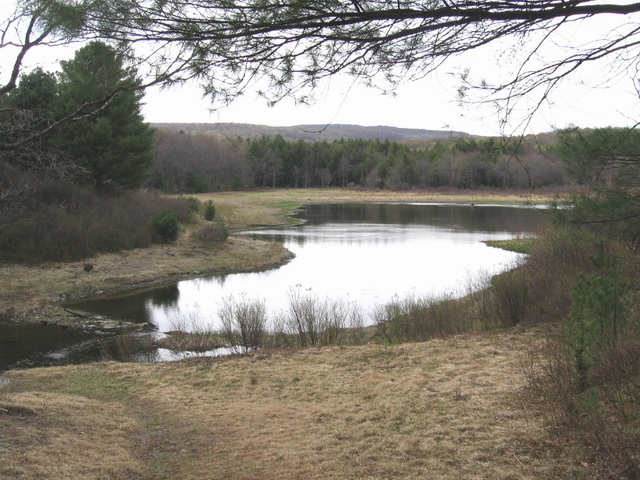
Frick Pond Lobdell Memorial Stone
